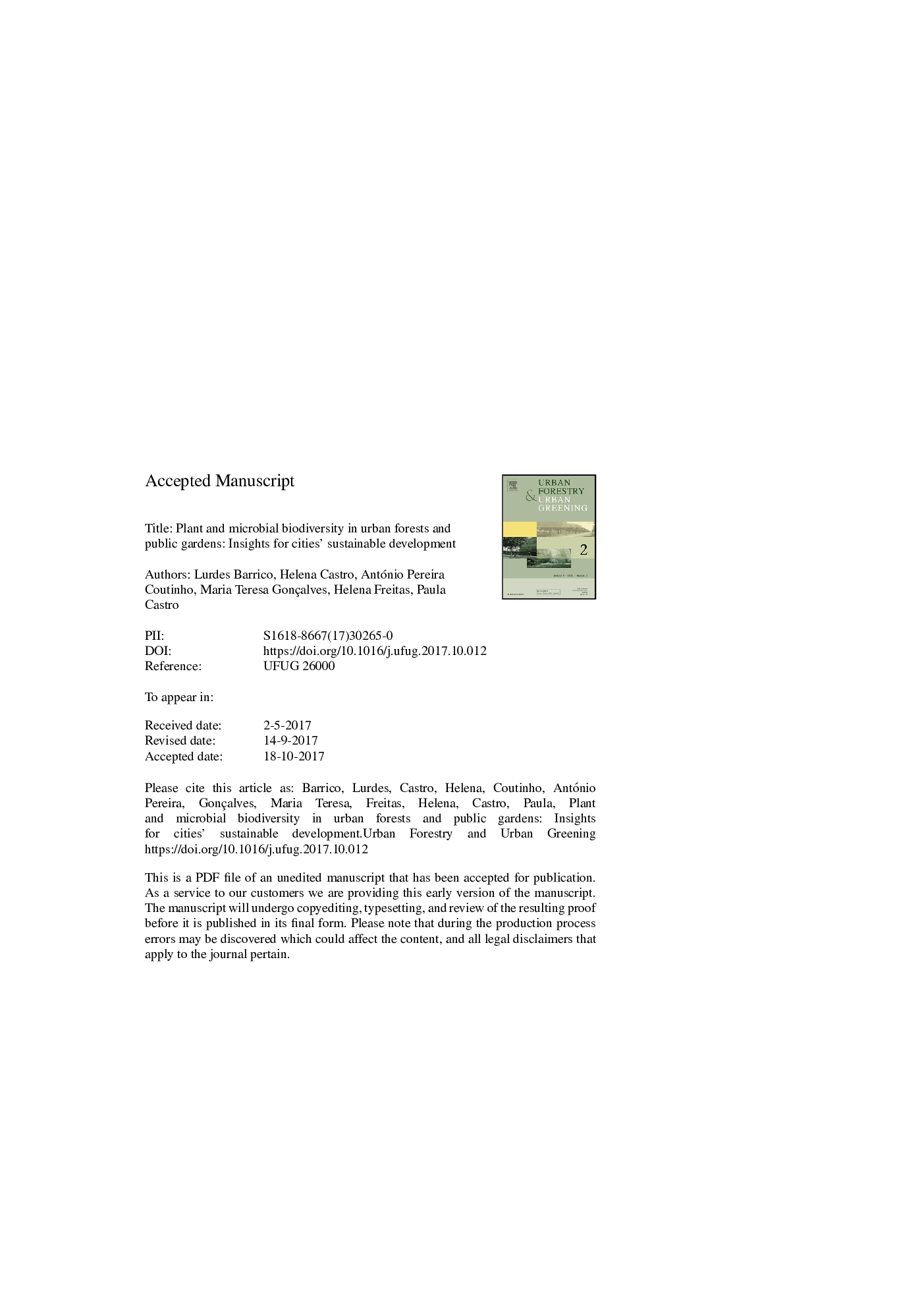| کد مقاله | کد نشریه | سال انتشار | مقاله انگلیسی | نسخه تمام متن |
|---|---|---|---|---|
| 6549373 | 1421861 | 2018 | 33 صفحه PDF | دانلود رایگان |
عنوان انگلیسی مقاله ISI
Plant and microbial biodiversity in urban forests and public gardens: Insights for cities' sustainable development
ترجمه فارسی عنوان
تنوع زیستی گیاهی و میکروبی در جنگل های شهری و باغ های عمومی: بینش برای توسعه پایدار شهرها
دانلود مقاله + سفارش ترجمه
دانلود مقاله ISI انگلیسی
رایگان برای ایرانیان
کلمات کلیدی
حفاظت، ارزش محیطی، کیفیت زندگی، جوامع میکروبی خاک، فضاهای سبز شهری، گیاهان عروقی،
ترجمه چکیده
با توجه به اینکه جمعیت جهان به طور فزاینده شهری بیشتر می شود، حفاظت از فضاهای سبز شهری مسئله مهمی در دستور کار سیاسی در سراسر جهان می شود. این فضاها می توانند تاثیرات محیطی منفی شهرنشینی و بهبود کیفیت زندگی را کاهش دهند. با هدف افزایش دانش در تنوع زیستی شهری، تنوع گیاهان عروقی و جوامع میکروبی خاک (قارچ ها و باکتری ها) را در دو نوع متفاوتی از فضاهای سبز شهری (باغ های عمومی و جنگل های باقیمانده) در شهر کویمبرا (پرتغال) مقایسه کردیم. ما 252 تاکسی از گیاهان عروقی پیدا کردیم که 58 درصد بومی و 42 درصد عجیب و غریب بودند. اگر چه شاخص های تنوع کلی در هر دو نوع از فضاهای سبز مشابه بود، غنای گونه و درصد پوشش تاکسون های بومی در جنگل ها به طور معنی داری بیشتر از باغ ها بود. به طور کلی جوامع گیاهی در دو نوع فضاهای سبز متمایز بودند. ما متغیرهای زیاد در میان باغ ها را پیدا کردیم، که با گیاهانی که در باغ ها تعیین می شود توسط انسان، به جای فرایندهای رقابتی یا جانشینی، سازگار است. جالب توجه است که تفاوت بین باغ ها و جنگل ها نیز برای جوامع باکتری و قارچی قابل مشاهده است که نشان دهنده ارتباط بین جوامع بالا و زیر زمین است. ما نشان دادیم که با توجه به منشاء آن، جنگلهای باقیمانده تاکسی گیاه را با ارزش های حفاظت شده و اکولوژیکی بالا می برند. همچنین نشان داد که درختان دارای درصد بالایی از گونه های عجیب و غریب هستند که ما را به نتیجه می رساند که گونه های بومی گیاهان باید در این فضاها تأکید بیشتری داشته باشند. برنامه ریزان شهر باید با استفاده از یک دیدگاه اکولوژیکی در برنامه های مدیریت خود برای افزایش سلامت انسان و کیفیت محیط زیست، شهرت را ارتقاء دهند.
موضوعات مرتبط
علوم زیستی و بیوفناوری
علوم کشاورزی و بیولوژیک
جنگلداری
چکیده انگلیسی
As the world's population gets increasingly more urban, the preservation of urban green spaces becomes an important issue in the political agenda worldwide. These spaces may mitigate the negative environmental impacts of urbanisation and improve quality of life. Aiming to increase knowledge in urban biodiversity we compared the diversity of vascular plants and soil microbial communities (fungi and bacteria) in two contrasting typologies of urban green spaces (public gardens and remnant forests) in the city of Coimbra (Portugal). We found 252 taxa of vascular plants of which 58% were native and 42% exotic. Although overall diversity indices were similar in both typologies of green spaces, species richness and percentage cover of native taxa were significantly higher in forests than in gardens. Overall, plant communities in the two typologies of green spaces were distinct. We found high variability among gardens, which is consistent with vegetation in gardens being determined by man rather than by competitive or successional processes. Interestingly, the disparity between gardens and forests was also visible for both bacterial and fungal communities indicating an association between above and below-ground communities. We showed that, due to their origin, remnant forests harbour plant taxa with high conservation and ecological values. It also showed that gardens have higher percentage of exotic species, which led us to conclude that native plant species should be given more emphasis in these spaces. City planners should promote urban development by incorporating an ecological perspective into their management plans to enhance human health and global environmental quality.
ناشر
Database: Elsevier - ScienceDirect (ساینس دایرکت)
Journal: Urban Forestry & Urban Greening - Volume 29, January 2018, Pages 19-27
Journal: Urban Forestry & Urban Greening - Volume 29, January 2018, Pages 19-27
نویسندگان
Lurdes Barrico, Helena Castro, António Pereira Coutinho, Maria Teresa Gonçalves, Helena Freitas, Paula Castro,
